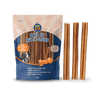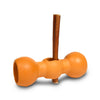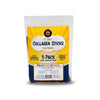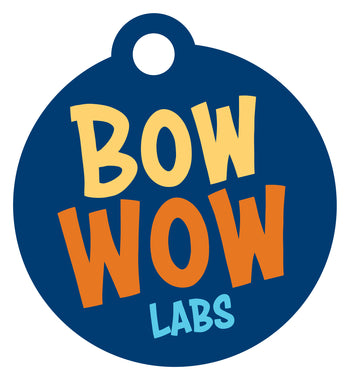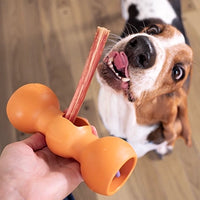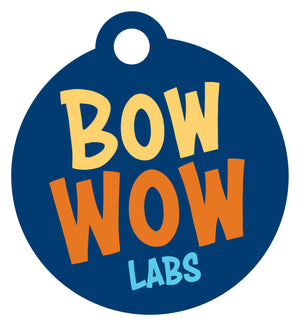I don’t know about you, but my schedule is nonstop. So, when I find a way to multitask (that actually works), I jump all over it! Now, imagine this: what if there was a way to multitask with your dog? No, I don’t mean listening to the latest podcast while playing ball…I’m talking about something much better. Imagine keeping your pup happily engaged while also supporting their joints, digestion, dental health, skin and coat.
Sounds too good to be true? It’s not. It’s as simple as offering your dog a collagen stick to chew. Yep, one chew with multiple benefits. But don’t just take my word for it—let’s break down the benefits of collagen for dogs and why these sticks might just become your (and your dog’s) new favorite go-to chew.
What Is Collagen, and Why Does It Matter for Dogs?
Collagen is a structural protein that makes up nearly 30% of the total protein in a dog’s body. It’s found in connective tissue, skin, tendons, ligaments, cartilage and even the lining of the digestive tract. Think of it as the “glue” that helps hold everything together and keep tissues strong and resilient.
As dogs age, or even just go through active lifestyles or minor injuries, their natural collagen production slows down. That’s where supplementation comes in.
Collagen sticks, typically made from beef hide (not to be confused with rawhide) or other natural animal sources, offer a bioavailable way to give your dog more of this vital protein in a form that engages their natural instincts of chewing.
1. Joint Support and Mobility
Collagen is probably best known for its role in joint health, and for good reason. It helps maintain the structure and strength of cartilage, that flexible cushion between bones that keeps movement smooth and pain-free. As dogs age, or if they’re dealing with arthritis, stiffness or just years of wear and tear, their natural collagen production slows down and that cushioning can start to break down. By providing dietary collagen to your dog’s diet, you can help support their joint health. In fact, a recent study using UC-II collagen showed a significant improvement in dogs' mobility, evidencing that you can effect change! 1
Now, when I say joints, you probably think about your dog’s limbs and their mobility. But there are other joints, like the temporomandibular joint (TMJ), that are equally important, especially when it comes to chewing. The health of the TMJ is essential for proper jaw function and works in close coordination with the muscles of mastication, while also indirectly engaging stabilizing muscles in the neck and spine.
So, when you offer your dog a collagen stick, you’re not just supporting their ability to run and play, you’re also supporting the muscle and joint function around their jaw that allows them to engage in their favorite activity ever, chewing!
2. Gut Health and Digestive Support
Science is continuing to peel back the numerous connections between gut health and overall health, as well as its connection between the brain and other organs. And guess what impacts gut health? You guessed it, collagen.
Collagen contains two powerful amino acids, glycine and glutamine, that help repair and maintain the mucosal lining of the digestive tract. These nutrients act as fuel for the enterocytes (the cells that line the gut) and play a critical role in keeping that barrier strong and resilient. 2 When the gut lining is compromised, it can lead to a condition often called "leaky gut," where undigested food particles or toxins slip through into the bloodstream. This can contribute to chronic inflammation, immune issues and even skin problems.
By helping to support the gut lining, collagen can improve nutrient absorption, calm inflammation and strengthen your dog’s immune defenses, too. So, if your pup deals with loose stools, recurring digestive upset or skin flare-ups tied to gut imbalance, collagen may offer gentle, foundational support from the inside out.

3. Skin and Coat Health
You’ve probably heard the phrase, “Healthy skin starts from within,” and it couldn’t be more true for our dogs. While a natural shampoo or conditioner might offer a quick surface-level shine, lasting skin and coat health comes from nourishing the body on the inside.
Collagen plays a central role here. It’s a key structural protein in the skin that supports the growth of new cells, helps replace dead ones, maintains elasticity, balances moisture and strengthens the skin barrier overall. 3 For dogs dealing with dry, flaky skin or seasonal itchiness, collagen offers the raw materials their bodies need to repair, rebuild and restore the skin from within.
And what does this mean? When your dog has a healthier skin barrier, they will also end up with a shinier, more vibrant and lustrous coat. Thank you, collagen sticks!
4. Dental Health Benefits
While collagen sticks aren’t a replacement for regular tooth brushing, they can offer some dental benefits. As your dog chews, the mechanical action helps gently scrape the teeth, which may reduce plaque buildup over time. Chewing also stimulates saliva production, and that saliva helps naturally “rinse” the mouth and wash away bacteria.
And here’s a bonus we love: chewing satisfies your dog’s natural urge to gnaw, which studies show can reduce boredom, anxiety and even destructive behaviors. 4
Now, unlike traditional rawhide chews, often processed with harsh chemicals and hard on the gut, high-quality collagen sticks are much easier to digest and offer actual health benefits. And for extra peace of mind, especially with enthusiastic chewers, offering them in a safety device like the Bow Wow Buddy® can help prevent gulping and make chew time safer.

What to Look for in a Collagen Stick
Not all chews are created equal. Here are a few things to keep in mind:
- Sourcing matters: Look for collagen sticks made from grass-fed, pasture-raised animals without added chemicals, artificial flavors or preservatives.
- Easily digestible: High-quality collagen is generally easier to digest, but always monitor your dog to make sure they chew safely.
- Size-appropriate: Choose a size and shape that fits your dog’s chewing style to prevent gulping or choking.
How Often Should You Offer Them?
You don’t need to offer collagen sticks daily to see benefits. Even a few times a week can provide meaningful support, especially when paired with a nourishing, species-appropriate diet.
Think of collagen sticks as both a supplement and an enrichment tool, something that supports wellness while giving your dog a job to do. Now that’s multitasking at its best, wouldn’t you agree?
Johnna Devereaux is a Clinical Pet Nutritionist, canine wellness expert and Chief Nutrition Officer for Bow Wow Labs.
* This article is for informational purposes only. It is not, nor is it intended to be, a substitute for professional medical or veterinary advice, diagnosis, or treatment and should never be relied upon or perceived as specific medical or veterinary advice.
**The points of view expressed above are those of our clinical nutritionist and are supported by science, her education and experience. We are committed to providing the best, most straightforward, and most helpful information possible to help keep your dog happy, healthy and safe.
References:
1. Stabile M, Fracassi L, Lacitignola L, et al. Effects of a feed supplement, containing undenatured type II collagen (UC II®) and Boswellia Serrata, in the management of mild/moderate mobility disorders in dogs: A randomized, double-blind, placebo controlled, cross-over study. PloS One . 2024;19(10):e0305697. doi:10.1371/journal.pone.0305697
2. (PDF) Characteristics of the Digestive Tract of Dogs and Cats. ResearchGate. August 3, 2021. Accessed May 19, 2025. https://www.researchgate.net/publication/379871680_Characteristics_of_the_Digestive_Tract_of_Dogs_and_Cats
3. Leverett K, Manjarín R, Laird E, et al. Fresh Food Consumption Increases Microbiome Diversity and Promotes Changes in Bacteria Composition on the Skin of Pet Dogs Compared to Dry Foods. Anim Open Access J MDPI . 2022;12(15):1881. doi:10.3390/ani12151881
4. Kubo K ya, Iinuma M, Chen H. Mastication as a Stress-Coping Behavior. BioMed Res Int. 2015;2015:876409. doi:10.1155/2015/876409

